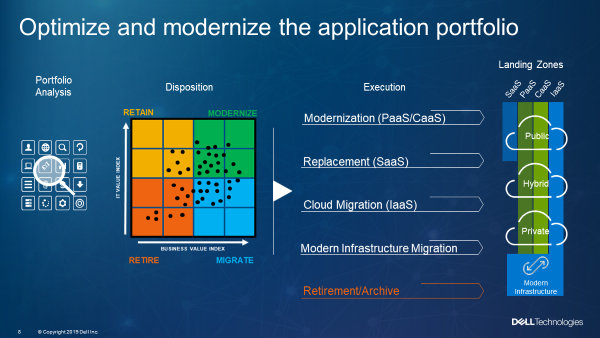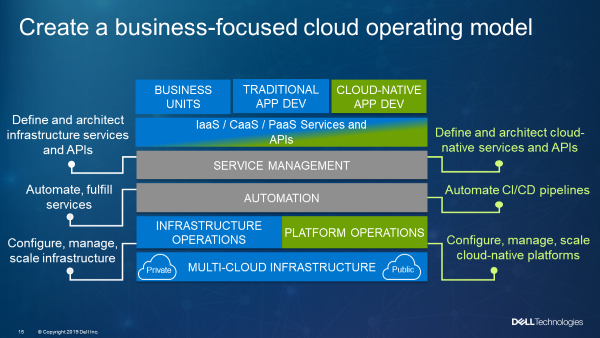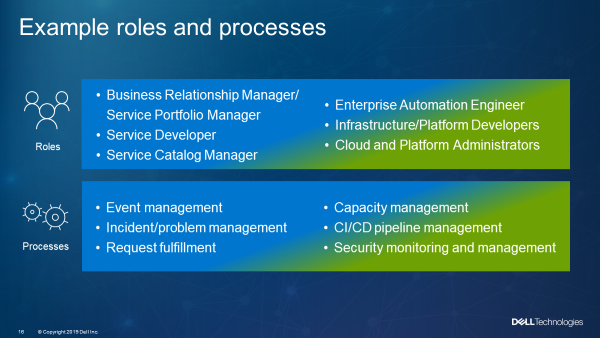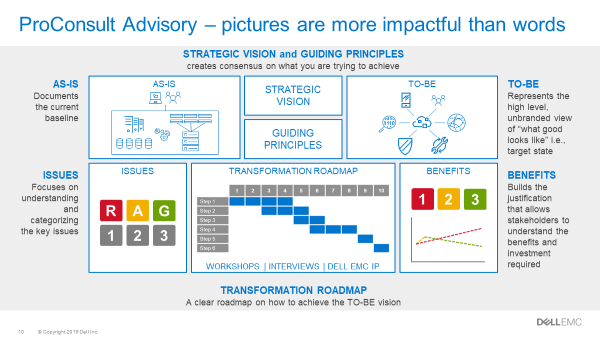Dell Technologies recently announced the new Dell Technologies Cloud, designed to make hybrid cloud environments simpler to deploy and manage. It removes cloud complexity by offering consistent infrastructure and operations across public and private clouds and the edge, regardless of location. Dell Technologies Consulting provides a variety of services to help customers develop and execute their cloud strategy.
Cloud Strategies are Driven by Workloads
Your cloud strategy should be dictated by the needs of your applications. If you are reading this, you may be planning processing at the edge and/or using public cloud offerings for some part of your application portfolio.To eliminate the possibility of an expensive mistake, you’ll want to quickly profile your applications to determine which ones should be migrated first and whether or not any of them need to be modernized/refactored first as shown in Figure 1. Dell Technologies Consulting uses a consistent, repeatable framework for evaluation, so that you can analyze apps in groups. We use a tool-based methodology that identifies and weights critical business priorities to provide an accurate view of the business importance of individual apps in the portfolio. Functional, technical, and business attributes then inform cloud suitability and ultimately cloud selection recommendations. For each application, we include a relative cloud fit index describing how easily the application may be migrated. Based on this analysis, applications are then prioritized into groups that are migrated to, and/or refactored for, the new cloud platform.

Create a Cloud Operating Model
Effective cloud operating models are founded on a service-focused approach to IT. Organizations need to create roles and processes to support both service delivery and the underlying infrastructure. Figure 2 identifies four operational areas to support this model: service management, automation, infrastructure operations and product platform operations.
Service management and automation are shared operations that are supported by both IT and app dev teams to manage the lifecycle of services and APIs. This includes defining and architecting services and APIs, building the services and maintaining the service catalog. Automation includes provisioning, build and release management, and metrics and monitoring. This is where you fulfill service requests, automate CI/CD pipelines, and monitor and measure the infrastructure, the product platform, and the applications.
Infrastructure operations is where you would manage and support the infrastructure, manage and support the cloud environment, and build and expose infrastructure APIs. Platform operations is where you would manage and support the product platform, and build and expose application APIs.

Some example roles and processes are shown in Figure 3. If you’re an existing VMware user you may already have many of these roles and processes in place, such as Service Developer, Service Catalog Manager, and Cloud Administrator. The key here is that the roles and processes are no longer focused on just infrastructure services, but also CaaS/PaaS services, infrastructure APIs, and application APIs. For example, the Service Portfolio Manager works with the lines of business and application developers to define IaaS and PaaS services, infrastructure APIs, and application APIs. The Enterprise Automation Engineer supports automation for both provisioning and build and release management processes.
To make this successful, infrastructure and app dev teams need to come together and share service management and automation functions. IT needs to provide the architecture that enables the delivery of services, whether on-prem or brokered. App dev needs to make sure that the applications they build, and their APIs, include IT governance, security, and compliance standards. Both organizations need to collaborate on the APIs needed for provisioning, CI/CD pipelines, and monitoring and operating the product platform.

Extend, Integrate, and Ensure Resiliency and Software-Defined Networking
Dell Technologies Consulting can also help extend the capabilities of the Dell Technologies Cloud and integrate it into your enterprise infrastructure. This can include adding service blueprints to your VMware vRealize service catalog, integrating with existing third party technologies such as your CMDB, or creating internal service pricing including chargeback or showback processes.
As you move applications to your hybrid cloud, you need to take a fresh look at your availability recovery strategy. First, you’ll need to validate the business service level expectations. Then you’ll want to evaluate recovery for your hybrid cloud applications. Considerations include which clouds those applications reside, which clouds are best suited technically, and the capabilities of your recovery operations team and processes to determine the best recovery approach and operational procedures for cloud-based recovery. Hybrid cloud recovery is now more seamless as recovery options become more comparable across compatible private and public clouds (e.g., Dell Technologies Cloud Platform between VMware private clouds and VMware on AWS). Evaluate trade-offs between optimizing applications for recovery in any single cloud ecosystem vs. the complexity of managing multiple cloud recovery options across your application portfolio.
Networking is another area of your cloud architecture where you’ll want to focus attention. Some networking teams try to layer cloud on top of already complex wide-area networking topologies. However, many IT organizations are already seeing benefits by leveraging software-defined networking technologies (e.g., VMware NSX) to provide better management and monitoring of cloud networking traffic, more effective network security (e.g., through micro-segmentation) and more flexible policy-based networking services. These policy-based networking services can also simplify hybrid cloud networking. Some leading IT organizations are further extending software-defined networking to their wide-area networks to provide similar benefits for their multi-cloud architectures. You should consider the pace and extent to which you incorporate software-defined networking throughout your network architecture.
A Strategy and Roadmap Can Get You Started
If you really aren’t sure where to start with hybrid cloud, ProConsult Advisory for Multi-cloud can help you create a transformation plan in six weeks or less. We can work with you to refine your cloud strategy, get your stakeholders aligned, assess your current state, define the target state, document the cost savings and benefits, and build a holistic roadmap to move forward quickly.



